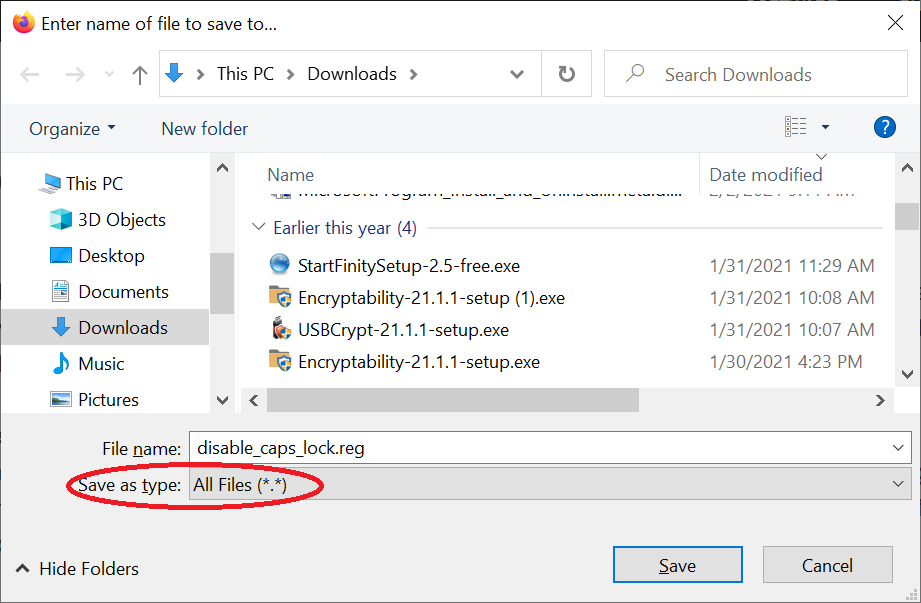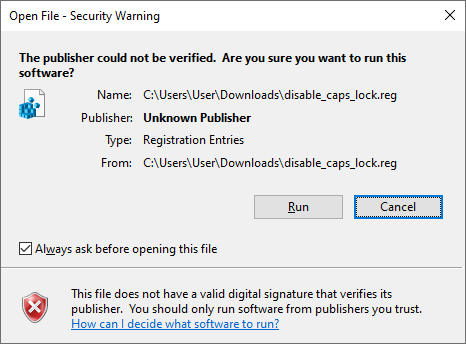How to reprogram or disable CAPS LOCK key
If you often find yourself typing long lines of text containing nothing but capital letters, you are probably very fond of the CAPS LOCK key. For the rest of us, the CAPS LOCK key is more of a nuisance than help. Fortunately, there is a way to change the way this key operates or even disable this key completely, so that when you press it accidentally, it does nothing.
A quick note before we begin: the instructions below assume you use Windows 11 or Windows 10, but they should work for the older versions of Window, such as Windows 7, XP, or Vista, as well. Just keep in mind that you may see slightly different messages or commands. Also, if you share your computer with others, this change will affect all users of the computer, not just you.
To stop the CAPS LOCK key from working, all you need to do is make a small modification to Windows Registry. To do that, right click on the link below, and choose Save link as (or a similar command, depending on your web browser) to download the file disable_caps_lock.reg to your computer:
When the Save As screen appears, make sure to change the file type from Text to All files:

Now use File Explorer to open your Downloads folder and double-click on the file that you had just downloaded. It should be listed as disable_caps_lock.reg or just disable_caps_lock, depending on your File Explorer settings. Double-click on it and you will probably see a message similar to the following:

This warning is expected and is valid: you should not open random files you download from the internet, because if someone tricks you into downloading a malicious file, it can really harm your computer.
Fortunately, the registry files are actually text files that you can examine before letting Windows use them. To be on the safe side, press Cancel for now and then right-click on the file disable_caps_lock.reg, choose Open with from the menu, and then select Notepad as the application to open it with (leave the Always use this app to open .reg files unchecked, because you do NOT want to always open them with Notepad, you only want to do that this one time only.)
Now if the same warning is displayed, press Run and you should see the following text within the Notepad window:
Windows Registry Editor Version 5.00 [HKEY_LOCAL_MACHINE\SYSTEM\CurrentControlSet\Control\Keyboard Layout] "Scancode Map"=hex:00,00,00,00,00,00,00,00,02,00,00,00,00,00,3a,00,00,00,00,00
As you can see, this file will modify the entry named Scancode Map under the key Keyboard Layout, which is what we expect. (If you see some other entries in the script, and you don't understand what they mean, get someone who knows more about the Registry for advice before continuing.) By the way, if you cannot download the registry file using the link above because your security software prevents such downloads, you can use Notepad and the text above to create such a file yourself.
After examining the contents of the file disable_caps_lock.reg with Notepad and making sure the contents is OK, close Notepad and double-click on the file disable_caps_lock.reg again. Press Run this time to proceed and you should see another prompt, this time from User Account Control, asking you to allow Registry Editor to make changes to your computer. Press Yes to allow.
(If you don't see such a prompt and Notepad opens instead Registry Editor, it probably means that you had downloaded the file as a Text file. Go back to the top of this article and read the note about changing the type of the file from Text to All files before downloading it.)
After approving Registry Editor to run, it will probably ask you the third time, are you sure you want to continue? (Windows is really trying hard to keep you safe, isn't it?)

Press Yes one final time and then OK the message informing you that the keys and values have been successfully added to the registry.
![]() Password-protect and hide personal files and folders with Folder Guard for Windows 11,10,8,7.
Password-protect and hide personal files and folders with Folder Guard for Windows 11,10,8,7.
User rating: ![]() 4.7 / 5
4.7 / 5
Purchase
or
download a free trial.
Read more...
You are almost finished, all that's left to do is restart the computer, by using the Start button and choosing Power - Restart from the menu. After the computer is back on, try pressing the CAPS LOCK key, it should not do anything now.
What if you don't want to disable the CAPS LOCK key, but assign a different, more useful function to it? For example, some people may find it convenient to make the CAPS LOCK key operate in the same was as the CTRL key. To do that, use the following registry file, in exactly the same way as described above:
A final note: if you ever decide that you want the CAPS LOCK key to become operational again, use Registry Editor to delete the Scancode Map value from the Keyboard Layout, and after you restart the computer the CAPS LOCK key should start working again.
If you want to link to this article, you can use this HTML code: <a href="https://www.winability.com/how-to-disable-caps-lock-key/">How to reprogram or disable CAPS LOCK key</a>
Read more
- How to disable Adobe's ability to scan all of your organization's documents for generative AI.
- [SOLVED] How to disable Taskbar Thumbnail Preview in Windows 11.
- How to restrict access to Microsoft Store app with Folder Guard.
- Tired of the Your password has expired and must be changed prompts? Here is how to stop them.
- How to move Pictures and other folders to Virtual Encrypted Disk.
- How to disable Fast Startup if you use encryption software.
- How to restore Videos, Pictures, and other folders in This PC in Windows 11.
- How to create a local user account in Windows 11 or Windows 10.
- How to enable or disable test signing mode in Windows.
- Email or SMS text messaging are NOT secure for two-factor authentication.
- Estimate how much you could save on electric bill with ActiveExit software.
- How to delete partition on Windows 11 or Windows 10.
- Forget VeraCrypt password? Here is how to recover it.
- Why do my desktop icons keep moving?
- How to create a private folder in Windows 11 and 10.
- How to restrict access to Windows Settings with Folder Guard.
 Suspending all contact with fascist Russia
Suspending all contact with fascist Russia- How to keep desktop icons from moving by running Icon Shepherd from command line.
- How to restrict access to Task Manager with Folder Guard.
- Take ownership of your files after access denied due to NTFS permissions.
- How to reprogram or disable CAPS LOCK key.
- Encryptability vs Folder Guard: which one to choose?
- Troubleshooting software removal problems using MSI files.
- Encryptability: Compare Personal and Business Licenses.
- How to add Group Policy and Local Security Policy to Windows 11 and 10 Home edition.
- [SOLVED] File is too large for the destination file system.
- Forget your WI-FI password? Find it in Windows 11 and 10 settings.
- What is FAT32 maximum file size limit?
- How to create a secret folder in Windows 11 and 10.
- How to easily password-protect Windows Linux folders with Folder Guard.
- Force DISKPART to delete EFI system partition in Windows 11 and 10.
- How to make Windows 11 and 10 recognize a cloned hard drive again.
- How to stop Windows 11 and 10 from using thumbnail preview icons for folders.
- How to hide pictures from the Photos app in Windows 11 and 10.
- How to save Windows Spotlight photos to your computer.
- How to move the OneDrive folder to an encrypted drive.
- Windows 10 fails to upgrade? Here is how to fix it.
- How to stop Microsoft Edge from opening PDF files.
- Preventing installations of specific programs with Folder Guard.
- Folder Guard licensing explained.
- Speed up the updates of the network folders.
- Make your Windows laptop work as a Wi-Fi access point.
- How to stop automatic Windows Update in Windows 10 and 11.
- [SOLVED] Windows cannot connect to the printer. Access is denied.
- Migrating encrypted data from TrueCrypt to USBCrypt.
- “The Microsoft account service is unavailable right now. Try again later.”
- Using DiffMerge as the external tool of AB Commander to compare plain text files.
- How to repair the icon cache and/or thumbnail cache in Windows 11 and 10.
- Transferring images between your PC and an Android device: Part 2.
- Transferring images between your PC and an Android device: Part 1.
- Case study: Using SoftDetective to suppress Corel Guide sign-in prompt.
- Using junction points to change the iTunes backup folder location.
- How to tell if my Windows computer is 32- or 64-bit?
- How do I stop Windows from rearranging my desktop icons?
- Organize your photo library with the Rename tool of AB Commander.
- Windows does not offer the NTFS format option? Here is how to bring it back.
- How to encrypt Firefox profile, bookmarks, and cookies.
- Restarting Windows 11, 10, and Windows 8 in the safe mode.
- Integrating AB Commander with Universal Viewer.
- How to delete a protected EFI system partition with Windows 11,10, 8, or 7.
- Using Folder Guard to protect from the social engineering attacks.
- How to erase Windows login password if you forget it.
- How to unhide a folder hidden with Folder Guard.
- How to repair Windows desktop icons with AB Commander.
- Slow network in Windows 7 Virtual PC? Speed it up!
- How to show drive letters first in AB Commander and Windows Explorer.
- What is my IP address?
- Why can’t I copy large files over 4GB to my USB flash drive or SD card?
- Test the strength of your password with USBCrypt.
- How to set up an external text editor for AB Commander.
- How to restrict Internet Explorer from downloading programs from the Internet.
- Personal vs business license for USBCrypt.
- Use Folder Guard to restrict access to Control Panel.
- Compare MySecretFolder and Folder Guard.
- Hide folders and make files invisible with Folder Guard.
- WINEXIT vs ActiveExit: automatically log off users from Windows.
- How to protect folder with password in Windows 11 and 10.
- How to restrict access and lock external drives with Folder Guard.
- How to password-protect Dropbox folder with USBCrypt.
- How to set up Folder Guard to stop downloading from the Internet.
- Is (Wipe the content) the same as (Secure Delete)?
- How to encrypt and protect the system C: drive with USBCrypt.
- Make it easier to return your lost encrypted drive.
- USBCrypt for users of Microsoft Office.
- How to start programs elevated from a batch file.
- How to make elevated programs recognize network drives.
- How to disable or enable hibernation.
- Using names and labels to organize USBCrypt drives.
- How to password-protect a USB flash drive.
- Always have a backup of your important files.
 Stand with Ukraine
Stand with Ukraine

